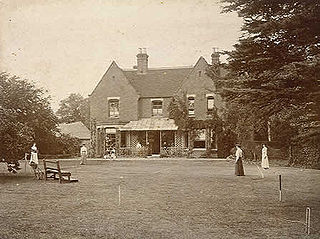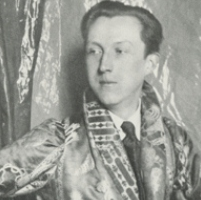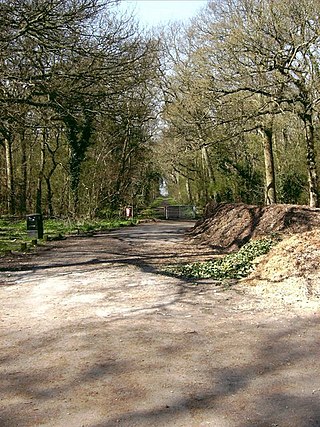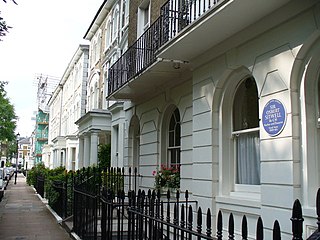
Dame Edith Louisa Sitwell was a British poet and critic and the eldest of the three literary Sitwells. She reacted badly to her eccentric, unloving parents and lived much of her life with her governess. She never married but became passionately attached to Russian painter Pavel Tchelitchew, and her home was always open to London's poetic circle, to whom she was generous and helpful.

Borley Rectory was a house located in Borley, Essex, famous for being described as "the most haunted house in England" by psychic researcher Harry Price. Built in 1862 to house the rector of the parish of Borley and his family, the house was badly damaged by fire in 1939 and demolished in 1944.

Minsden Chapel is an isolated ruined chapel in the fields above the hamlet of Chapelfoot, near Preston, Hertfordshire. Today it is a roofless shell, partly surrounded by a small wood, and accessible only by footpath. It is a Scheduled Monument and is Grade II Listed.

Sir Sacheverell Reresby Sitwell, 6th Baronet, was an English writer, particularly on baroque architecture, and an art and music critic. Sitwell produced some 50 volumes of poetry and some 50 works on art, music, architecture, and travel.

Eccentricity is an unusual or odd behavior on the part of an individual. This behavior would typically be perceived as unusual or unnecessary, without being demonstrably maladaptive. Eccentricity is contrasted with normal behavior, the nearly universal means by which individuals in society solve given problems and pursue certain priorities in everyday life. People who consistently display benignly eccentric behavior are labeled as "eccentrics".

Sir Francis Osbert Sacheverell Sitwell, 5th Baronet CH CBE was an English writer. His elder sister was Edith Sitwell and his younger brother was Sacheverell Sitwell. Like them, he devoted his life to art and literature.

The Enfield poltergeist was a claim of supernatural activity at 284 Green Street, a council house in Brimsdown, Enfield, London, England, between 1977 and 1979. The alleged poltergeist activity was centred on sisters Janet, aged 11, and Margaret Hodgson, aged 13.

Façade is a series of poems by Edith Sitwell, best known as part of Façade – An Entertainment in which the poems are recited over an instrumental accompaniment by William Walton. The poems and the music exist in several versions.

Ghost hunting is the process of investigating locations that are purportedly haunted by ghosts. The practice has been heavily criticized for its dismissal of the scientific method. No scientific study has ever been able to confirm the existence of ghosts. Ghost hunting is considered a pseudoscience by the vast majority of educators, academics, science writers and skeptics. Science historian Brian Regal described ghost hunting as "an unorganized exercise in futility".

Sir George Reresby Sitwell, 4th Baronet was a British antiquarian writer and Conservative politician who sat in the House of Commons between 1885 and 1895.
Julian Osgood Field (1852–1925) was an American socialite and writer. Some of his works were published under the pseudonyms X.L. or Sigma.
The Ghost Club is a paranormal investigation and research organization, founded in London in 1862. It is believed to be the oldest such organization in the world, though its history has not been continuous. The club still investigates mainly ghosts and hauntings.

The Black Lady of Bradley Woods is a ghost which reportedly haunts the woods near the village of Bradley, Lincolnshire, England.

Hannah Beswick, of Birchin Bower, Hollinwood, Oldham, Greater Manchester, was a wealthy woman who had a pathological fear of premature burial. Following her death in 1758, her body was embalmed and kept above ground, to be periodically checked for signs of life.

St Laurence Pountney was a Church of England parish church in the Candlewick ward of the City of London. It was destroyed in the Great Fire of 1666, and not rebuilt.

Greenhill is an area of Hampstead in the London Borough of Camden in Greater London. The name is topographically derived.

The Rhydspence Inn is a 14th-century inn situated on the Wales-England border and within the Wye Valley overlooking the Welsh hills and Herefordshire countryside. According to English Heritage it was built in the 16th century with 19th and late 20th century additions. It is a former gentry house and was not built as an inn. Until well into the sixteenth century droving on any scale in the Marches was far too risky. In such a lonely and lawless area, cattle rustling was rife, often by the authorities themselves. The Land of Speis means simply land of thorn bushes, which it is. The name is still in use today. Abbey Cwm Hir was always a modest house, the monks were predominately Welsh and apart from the Abbey's officers would have little occasion to leave it.

Burford Priory is a Grade I listed country house and former priory at Burford in West Oxfordshire, England owned by Elisabeth Murdoch, daughter of Rupert Murdoch, together with Matthew Freud.
English Eccentrics is a chamber opera in two acts by Malcolm Williamson to an English libretto by Geoffrey Dunn, based on Edith Sitwell's 1933 book, The English Eccentrics. It was commissioned by the English Opera Group. The opera requires the cast to make many quick changes of roles between scenes, and contrives the confrontation of several of the characters, who did not meet in real life.

Carlyle Square is a garden square off the King's Road in London's Chelsea district, SW3. The square was laid out on market gardens and was originally called Oakley Square. It was later named in honour of the writer Thomas Carlyle in 1872.

















